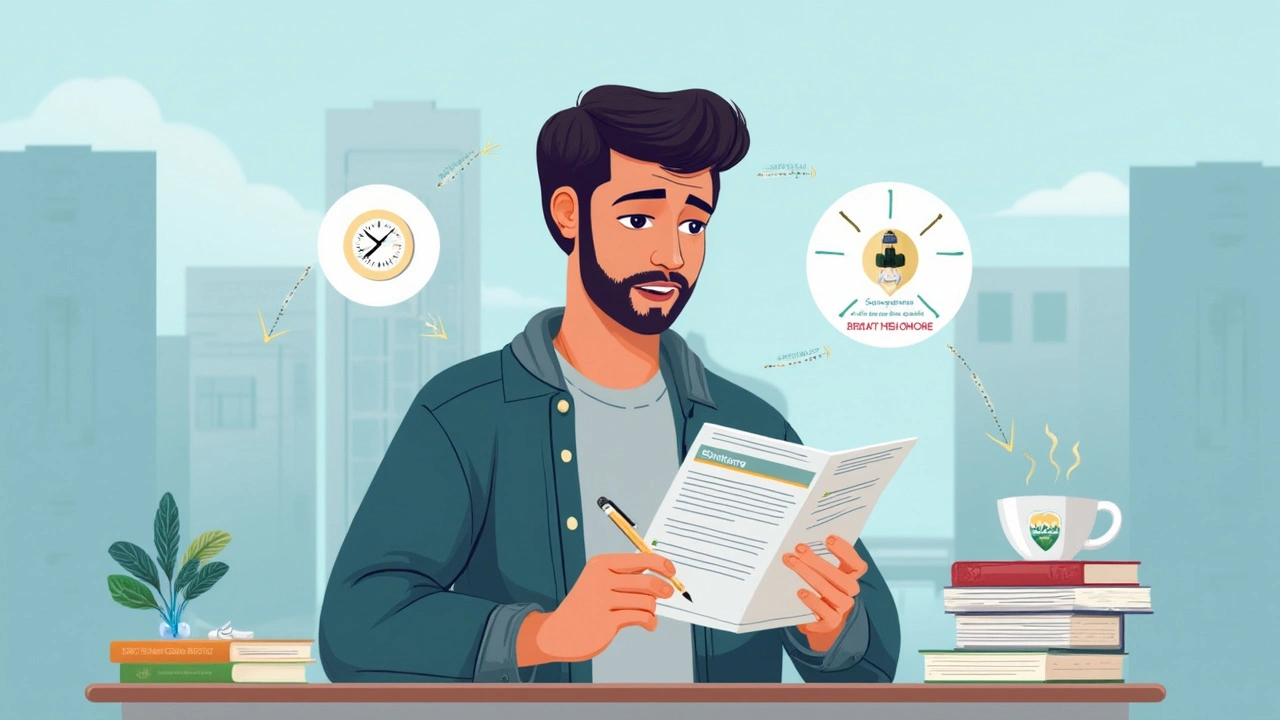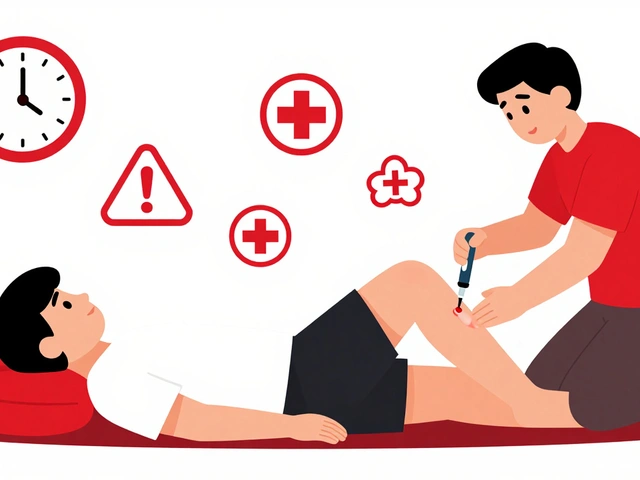
Wake up, pop a pill, and watch your world slow down just enough to finish that task you’ve been putting off for ages. Sounds ideal, right? For a lot of people with ADHD, Strattera is the medicine that makes mornings feel like less of a battle. But the story isn’t all sunshine and easy mornings. Strattera, known in the doctor’s office as atomoxetine, stands apart from the classic ADHD drugs everyone’s heard about. No, it's not a stimulant. That twist alone makes it a hot topic among doctors, parents, and adults trying to reclaim their focus. So what’s the deal—magic cure or just another overhyped pill?
What is Strattera and How is it Different?
Strattera doesn't play in the same sandbox as Adderall or Ritalin. At its core, the biggest difference is that Strattera is a nonstimulant. While stimulants rev up your brain with amphetamines or methylphenidate to boost dopamine and norepinephrine, Strattera keeps it simple—it only targets norepinephrine. Think of it as the quieter sibling who still gets things done, just without all the jitters and rush.
The FDA gave Strattera its stamp for treating ADHD all the way back in 2002. It’s been around the block, racking up success stories, skeptics, and studies just like its stimulant counterparts. The drug’s active ingredient, atomoxetine, also helps explain why Strattera works differently. Instead of giving you a dopamine surge (that famous "reward chemical"), Strattera mainly stops norepinephrine from being reabsorbed. This means more norepinephrine hangs around, and for people with ADHD, this helps the brain process info better—think attention, memory, and impulse control.
Let’s bust a myth: Strattera won’t get you buzzed, and it doesn’t have the addiction risk that follows stimulant meds. Kids, teens, and adults with a history of anxiety, substance abuse, or certain heart issues often get pointed toward Strattera for this very reason. For parents nervous about handing their kid a controlled substance, hearing “nonstimulant” is a huge relief. And unlike most stimulants, Strattera isn't a Schedule II drug which means it’s easier to get filled and refilled on schedule, no need to visit the doctor every single time.
You also won’t get the instant kick some people expect from ADHD pills. Strattera is a slow burn—it can take several days, or even weeks, before you notice a difference. Some research says most users need about four to twelve weeks for full effect. That requires some patience, which isn’t exactly easy for someone dealing with ADHD to begin with.
It’s worth noting there's no “one-size-fits-all” with ADHD either. For some, Strattera is like night and day. They notice fewer outbursts, less forgetfulness, and maybe grades even go up. For others, it falls flat—they need stimulants, or a different approach all together. Genetics, your exact brain chemistry, and other meds you're on can all influence how Strattera works for you.
Here's an eye-opener: according to a 2023 meta-analysis published in 'The Journal of Child Psychology and Psychiatry,' about 40–50% of patients see a “clinically meaningful” improvement with Strattera. That's not small potatoes, but it's also not a home run for everybody. Remember, though, medications alone rarely solve all the problems. Most experts push for a combo—meds plus therapy or coaching to really help with daily life skills.
There’s even use for Strattera outside the ADHD world. Some doctors prescribe it off-label for mood disorders or where people suffer from both anxiety and attention issues. There’s ongoing research on that front, so you may hear about Strattera peeking into new territory soon.

The Ups and Downs: Side Effects, Safety, and What to Watch For
Pop culture makes it sound like meds will turn your life upside down in an instant, but side effects don’t always hit that hard. For Strattera, most folks report things like stomachaches, sleepiness, or dry mouth in the first week or two. Nausea is actually one of the top complaints, often hitting harder if you take your dose without food. The trick? Take it with a meal or snack. Still, if something’s messing with your stomach for weeks, call your doctor. There are tweaks they can make—sometimes just shifting from once-daily to splitting the daily dose eases problems.
The sleep question comes up a lot, too. Unlike stimulants that can make you feel like you just chugged a triple shot of espresso, Strattera can actually make some users sleepy, especially at the start. On the flip side, some people experience insomnia—everyone’s chemistry is different. You’ll want to keep notes, maybe use a sleep tracker, and bring your findings to the next checkup.
Some side effects deserve extra caution. In rare cases, Strattera can affect the liver, so doctors will keep an eye on your liver enzymes with occasional blood tests if any red flags pop up—like dark urine or yellow skin. There’s also a black box warning about suicidal thoughts in kids and teens. This sounds scary—and it’s not something to brush off—but the actual risk is small. Still, any changes in mood or sudden negative thoughts should get discussed with your doctor as soon as possible.
Let’s not forget about high blood pressure or heart rhythm issues. While this isn’t common, if you’re already dealing with heart problems, tell your doctor before starting. It’s not a medicine to take for granted or self-prescribe.
One question that comes up at almost every appointment: “Will I gain weight or lose it?” Good news—unlike stimulant meds, Strattera seems to have a mild effect on appetite for most people. You’re not likely to lose your appetite or drop weight rapidly. Still, a few do experience some appetite loss, mainly when first starting. If you're worried about growth in kids, the long-term data says Strattera doesn’t stunt height like some stimulants might, but regular checkups keep everyone honest.
Here’s a quick breakdown of Strattera side effects, based on reported stats:
| Side Effect | Chance of Occurring |
|---|---|
| Nausea | 20-25% |
| Sleepiness | 10-20% |
| Headaches | 16-18% |
| Decreased Appetite | 10-15% |
| Dry Mouth | 15-20% |
| Increased Heart Rate | 5-10% |
| Liver Issues | <1% |
Managing side effects boils down to communication. Track your symptoms, use a pillbox or reminder app, and ask your doctor honest questions. Sometimes, adjusting the dose or the time of day you take it can make all the difference in sticking with it or quitting.

Tips, Real-World Results, and What to Expect Day-to-Day
The biggest shock for many: you won’t notice magic on day one. This isn’t a sprint, it’s a marathon. Strattera usually builds up in your system over 1–3 weeks, sometimes taking up to 8–12 weeks for the full punch. Set your expectations right—some days you’ll wonder if it’s working at all, then it sneaks up on you, and one day you realize you finished a work project or didn’t lose your temper with your kid. That’s progress.
Forget the stories you’ve heard about ADHD meds wrecking your personality. With Strattera, most people say they feel like themselves, just with more control. You stay you—no weird emotional numbness. For students, this often means homework isn’t the enemy anymore. For adults, maybe you finally stop leaving your keys in the fridge or making impulsive decisions at work.
Here are concrete tips for getting the most out of Strattera:
- Always take it at the same time every day—consistency matters for blood levels.
- If you get stomach upset, take Strattera with food or right after eating.
- If you’re feeling sleepy, try moving your dose to the evening. If you can’t sleep, try the morning.
- Set a calendar reminder or use a pill-tracking app (try Medisafe or a smart watch alarm)—missed doses set you back, especially in the first month.
- Keep a quick journal noting focus, mood, appetite, and sleep. Show it to your doctor—it helps decide if the med’s working or if a tweak is needed.
- Don’t double up doses if you forget. Just take your next dose as scheduled.
- Let someone close to you know you’re starting a new med—tiny changes in behavior are easier for others to spot.
- If you notice liver warning signs (itchy skin, pale stool, or yellowing eyes/skin), call your doctor, not Google.
One of the most common questions I hear: is Strattera safe for long-term use? The answer, so far, is yes for most people. Several studies track kids and adults for years, and while everyone’s experience will vary, there’s no big red flag. Doctors do want to check blood pressure, weight, and mood every few months, especially in younger patients, just to be safe. As for withdrawal? There’s no chemical dependency or "crash" the way you get with some stimulants. You don’t have to sweat frightening stories about addiction.
For folks with anxiety, Strattera often does double duty. Stimulants can actually make anxiety worse, but Strattera sometimes relieves it, since norepinephrine's actions can help calm excess brain chatter. That said, occasionally people get more anxious or irritable the first week or two. This is why tracking mood is key—sometimes, just sticking with it or adjusting the dose smooths things out.
At the pharmacy, you’ll notice Strattera comes in capsules from 10mg up to 100mg. Most docs start you low and step you up over several weeks to minimize side effects and see what dose actually works. Crushing or opening the capsules isn’t recommended, since it can irritate the throat and is tough to dose exactly right. Swallow those capsules whole with a full glass of water.
Here’s a real-world hack straight from other users: pairing Strattera with therapy, executive function coaching, or good old-fashioned checklists can supercharge results. Meds don’t teach organization, but practice and external support bridge the gaps meds can’t fix. Maybe it's a color-coded planner, stickies, or reminders on your phone—whatever keeps you rolling forward without getting derailed.
If you’re a parent, keep an open channel with teachers and coaches. Sometimes the first signal a med is working—or not working—comes from school. Regular feedback means you spot problems before they blow up into bigger issues. Just remember, no medicine will replace encouragement and real routine at home.
Insurance? Here’s where things sometimes get sticky. Not every carrier is quick to cover brand-name Strattera, but the **strattera** generic, atomoxetine, usually gets approved. If you hit a wall, have your doctor’s office help with the appeal—they’ve been down this road a hundred times and know what paperwork will win over the insurance company.
If you’re switching from a stimulant to Strattera, don’t go it alone. Your doc should lay out an overlap plan. Quitting a stimulant cold turkey then starting Strattera immediately can leave you feeling off, so coordinated care really makes the transition smoother.
Last tip: keep your expectations realistic. Even the perfect medicine is just one tool in the ADHD toolkit. How you set up your day, manage stress, and connect with others all play a part in winning against distraction and chaos. Strattera gives your brain a better shot, but you steer the ship.
11 Comments
John Magnus
July 20, 2025 AT 16:42 PM
Admittedly, I found this article to be a concise yet critical primer on the pharmacodynamics of atomoxetine. Despite its acclaim as a nonstimulant alternative, one must not overlook the norepinephrine reuptake inhibition mechanism, which fundamentally differentiates it from amphetamine salts or methylphenidate.
Moreover, the risk profile it presents, particularly in terms of hepatic function alteration or cardiovascular implications, demands a rigorous risk-benefit analysis prior to prescription.
Did anyone else find the discussion somewhat lacking in terms of long-term efficacy data? In my experience, a nuanced understanding of chronic use outcomes is essential for truly informed consent.
Jessica H.
July 23, 2025 AT 00:22 AM
While this breakdown is quite informative, I feel there's a tendency to gloss over the emotional and psychological impacts that patients might endure, especially regarding side effects like mood swings which can be quite debilitating.
It’s crucial the article had stressed the importance of not just monitoring physical symptoms but also mental and emotional well-being continuously. Patients should not feel isolated when dealing with complex side effects, and more support systems need to be discussed.
angelica maria villadiego españa
July 25, 2025 AT 08:02 AM
I've been on Strattera for about a year now, and honestly, it was a game-changer for me because stimulants gave me terrible anxiety. The article touches on this, but I think the personal experience angle is missing. Not everyone reacts the same way, and it's so important to find what fits your body and mind.
I did have some side effects initially, like some nausea and sleepiness, but those faded away. Also, I appreciate the advice on taking the medication consistently — that made a big difference.
Tom Saa
July 27, 2025 AT 15:42 PM
Fascinating how these medications almost become metaphors for the struggles of control and chaos in life. Strattera’s nonstimulant nature symbolizes a quieter, slower path in a world obsessed with speed and instantaneous results.
But doesn't it feel like sometimes our attempts to mechanize or regulate our mental functions with meds might be missing the larger existential questions about attention and distraction in modernity?
Just throwing out some thoughts sparked by the article. Fascinating read, nonetheless.
Ted Whiteman
July 29, 2025 AT 23:22 PM
Yeah, sure, another ADHD med that's supposed to be the 'one size fits all' cure. I call BS on that. Too many people end up bouncing meds 'til they find the right cocktail. This article is a bit too rosy, ignoring how some folks get stuck with side effects that ruin their day-to-day.
And let's be honest, the pharmaceutical push here is real. Are we looking at actual patient-centric care or just another pill in the pipeline?
Dustin Richards
August 1, 2025 AT 07:02 AM
I must say, the article emphasizes safety well, but I would have liked more specific guidelines on what to do if someone experiences severe side effects. For instance, what are the exact red flags warranting immediate medical attention?
Also, the interplay of Strattera with other drugs is non-trivial. I'd appreciate some commentary on contraindications and safe combinations, considering many patients might be on multiple prescriptions.
Vivian Yeong
August 3, 2025 AT 14:42 PM
Honestly, articles like this tend to skew towards promoting medications without sufficient critique on their overall efficacy. I would have preferred more balance, highlighting alternative interventions like behavioral therapy or lifestyle changes as complements or even substitutes.
Reliance solely on pharmacological treatments can be a slippery slope, and the long-term implications remain underexplored here.
Reynolds Boone
August 5, 2025 AT 22:22 PM
Could someone explain how Strattera compares with stimulant medications in terms of cognitive benefits? I've read mixed reports about its ability to improve focus and executive function.
Does it truly match up or is it more about tolerance and fewer side effects?
I'm considering options for a friend and any real-world experiences would be appreciated.
Angelina Wong
August 8, 2025 AT 06:02 AM
Hey, speaking as someone who's helped friends manage ADHD, Strattera is definitely a solid option when stimulants aren't viable. From clinical perspective, it requires commitment and patience —it doesn't work overnight—and some people do experience mood-related side effects which necessitate close monitoring.
The article glossed over this a bit but I'd emphasize regular check-ins with a healthcare provider during the initial weeks.
It's also important to combine medication with behavioral strategies for the best outcomes.
suresh mishra
August 10, 2025 AT 13:42 PM
Interesting read, though I found some minor inaccuracies in the pharmacology descriptions. Atomoxetine’s selectivity for norepinephrine transporters doesn't mean dopamine pathways are untouched—they are affected indirectly, which influences clinical effects.
Clarity on this helps in understanding why some patients report benefits in attention despite it being a nonstimulant.






Marc Clarke
July 18, 2025 AT 09:00 AM
This article provides a great overview of Strattera and its role in ADHD treatment. I appreciate the focus on it being a nonstimulant, which can be a crucial option for people who don't respond well to or can't take stimulants.
The advice about monitoring side effects is super important, especially since Strattera can have different effects compared to more traditional meds. From what I’ve seen, it also requires a bit more patience to notice benefits because it doesn't act as fast as stimulants.
It's good to have clear stats and honest facts laid out like this — too often we just hear anecdotal content without much backing.